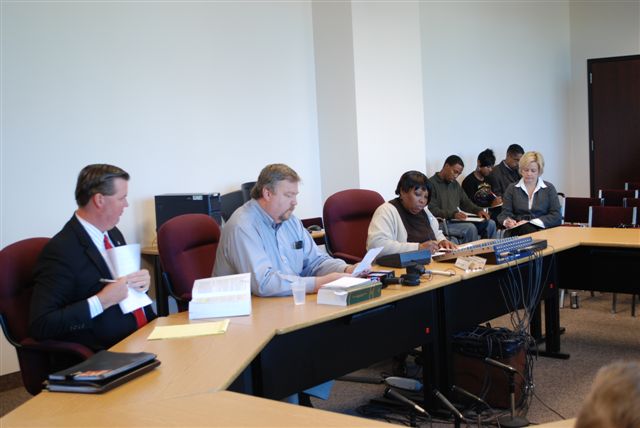Eric has been a public advocate for a number of causes through the years – some springing from or leading into work projects, others simply because of his desire to see better things for the community.

Project work advocating for others was facilitated by the consulting business Eric began in the 1990s, Echidna Design, allowing Eric to work on text, Web and promotional marketing for clients. Eric’s skills were no doubt also aided by his training in law at the University of North Carolina at Chapel Hill and at Villanova University

- Public Education – as PTA/PTSA president at his kids’ first two schools, Eric cheer-led school community and raised funds purchasing new signage and playground equipment at Brunson Elementary and beautification and signage at Hanes Middle. The great disparity in playground equipment at poorer neighborhood schools, and the general segregation of resources available to schools, led Eric to run in 1998 and 2002 for school board. Though unsuccessful politically, that led to Eric’s service as a local precinct chair, and to his designing the first Web sites for the local Democratic party and for then-new Winston-Salem mayoral candidate Allen Joines.


- Neighborhood Preservation – as board member of the West End Association, Eric crafted a long-term strategy document for improving and preserving his neighborhood; and as WEA President, he led a Millennium Campaign funding signage marking its historic district and beautifying Grace Court Park with a period clock and community time capsule [featured section image above and below] . He personally commissioned a keepsake limited edition print of Grace Court, served as WEA newsletter editor and, as WEA Treasurer, restored the group’s 501(c)3 status. Eric joined with other downtown stakeholders in the work of the Downtown Winston-Salem Partnership to promote entertainment, shopping and public safety issues there. He would later serve on the board of Neighbors for Better Neighborhoods and on the City-County Planning Department’s original South Central Area Plan advisory team. and often spoke in the media and at public meetings on issues affecting neighborhoods.


- Elections – appointed to a quasi-judicial post on the Forsyth County Board of Elections from 2003-2009, Eric served as Secretary, and later, Chair. He pushed for the purchase of paper-trail voting machines and expanded times and sites for early voting (including a first use of the local bus transit center), selected a new Elections Director, tried to introduce the national Kids Voting program, and gained certification as a trained Elections Board member. As a board member of the state’s Elections Boards Association, Eric pushed back on state attempts to alter the authority of local boards and change rules after an election starts,



- Public Art – After his Grace Court clock work, in 2000 Eric was appointed by Winston-Salem Mayor Jack Cavanagh to chair a Task Force on Public Art, which kick-started conversations between arts leaders and local officials but ended within a year with the election of a new mayor. In helping neighbors place a sculpture in Grace Court after the 2007 Historic West End Artsfest, Eric returned to envisioning with others the role of art and design in “placemaking.” He joined the local Arts Council’s Public Art and Design Committee as they explored the creation of a city public art plan and public art commission, and lobbied with the Creative Corridors Coalition, imagining design possibilities in the planned rebuild of the cross-town Business I-40 highway. Eric began sharing his own research and news of local efforts on his new blog Ars urbi serviat -“Art serving the city.” and helped lead community meetings seeking support for creative highway design and lobbied for public art. In 2013 Winston-Salem made a public art commitment and began a planning process, and in 2021 the new Salem Parkway features two innovative pedestrian bridges and a nearby US 52 bridge with a symbolic crossing Twin Arches design.


- Greenspace Preservation -returning to his family home in Gastonia, NC, Eric led two fights against commercial rezoning of a fourteen-acre wooded and wetland parcel that residential neighbors had battled for four decades. He went door-to-door to rally opposition with flyers, assembled a steering committee to fight, created a media catchphrase for both the parcel and the fight, started a blog to share the history of the parcel fights and current efforts, wrote editorials, created videos of the flooding made worse by development, invited political candidates to new monthly neighborhood meetings, raised money to hire an attorney, networked local media and a 300-person neighbor and friend e-mail list, and won a surprising unanimous victory. Eighteen months later a second smaller footprint proposal won a 4-3 approval in the last council meeting led by a leading development proponent, despite Eric’s work with a new rallying-cry blog and editorials, and media coverage and neighbor opposition. Though unable to “Keep Franklin Woods,” “No Big Box” development came. Academy Sports would later re-purpose an existing building in a nearby shopping center, a win-win for the town. And neighbors got a renewed sense of purpose and problem-solving in the fight.




